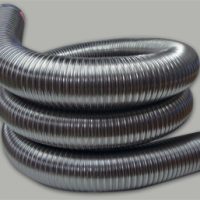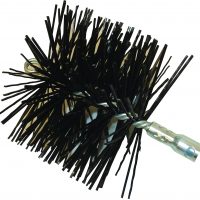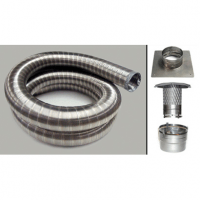Chimney tools used for cleaning
There are many different chimney tools that can be used for cleaning your chimney. In this article you will learn about what is available to you in order to properly clean your chimney flue.
Flue Brush
A flue brush is a chimney tool used to remove most creosote deposits from the interior of the chimney. The three most commonly used are:
* Oil tempered steel
* Stainless steel
* Polypropylene plastic
Flue brushes come in round, oval, square and rectangular shapes. Round and square are the most commonly used. They range in sizes from 5″ to 14″ in diameter.
Wire Brushes come in two types: Round and Flat. The bristles of the round -brush are made of an oil tempered steel, placed on a spindle in a two on two pattern. The round brush gives average scraping on the walls of the chimney. The flat wire brush is stiffer than the round. This means that they may not spring back into shape when cleaning past the damper. The flat brush works best for scraping the top using a glazed creosote removing chemical. The flat brush is gaining in popularity among chimney tools because of their above average scraping ability.
Polypropylene Brushes are softer than wire brushes. They can be used on many types of chimney liners and factory built metal chimneys. The polypropylene brush will not scratch the inside of the metal – chimney. The bristles are available in sizes from 1/8″ to 1/16″ in diameter. The thinner the bristles, the greater flexibility the brush will have. The polypropylene brush however has a less effective scraping action than the wire brushes.
Rotary Steel Cable chimney tool is used with an electric drill and special metal rods which are used to spin the cable. They do a great job cleaning the smoke chamber and also some of the heavier creosote on the flue.
Hand Brushes are the most commonly used chimney tool. These brushes come in wire, U shaped, pot brushes and wire brushes with attached scrapers. Hand brushes are used to clean the thimble area, smoke chamber, connectors, fireboxes, chimney caps and smoke shelves. There are hand brushes available that are soft for cleaning up soot and ash.
Chimney Rods
What Are Chimney Cleaning Rods? Chimney rods are tools used to push the brush thru the flue. Many of the chimney brushes available connect to these flexible rods. They thread together to give you the length you need.- Chimney rods are available in different materials such as fiberglass, metal, polypropylene and rattan.
Polypropylene rods are very flexible. Because of their flexibility, these rods are extreamly popular. However, because of this flexibility, they will not withstand prolonged, heavy duty use.
Fiberglass rods are the most commonly used because they offer a wide variety of flexible and rigid styles.
Metal rods are mostly used with rotary chimney cleaning systems, power brushing and for tile breakers.
Rattan rods are most useful for jobs that would require a very rigid, stiff rod. This rod would typically be used if scraping of creosote is required.
Chimney Cleaning System
What is a chimney cleaning system? A chimney cleaning system is a chimney tool designed to eliminate the need for climbing ladders, connecting and carring rods and brushes.
The chimney cleaning system uses a continous 60′ of rod along with an adjustable cleaning head. They are usually coiled inside a stainless steel basket.
Chimney cleaning systems can be used for medium to large sized chimneys either from the ground up, on its’ side or in the upright position.
Its’ flexibility allows it to adapt to most chimneys.
Tile Breakers
What are Tile Breakers? This is a rotary tool and is designed to break out clay tiles that are damaged. It is also used when relining a chimney and removal of flue tiles is necessary in order to make the flue -size bigger.
The tile breaker is made of hardend steel, usually about 1/2″ thick. They use a heavy drill along with heavy duty rods. This is needed in order to break the clay tiles into small pieces which makes it easier to remove.
These chimney tools are available in three sizes:
* 4″ X 4″ Single breaker. This is used for breaking out flues that are 8″ X 8″ or 7″ X 11″
* 4″ X 4″ Double breaker. This is used for breaking out flues that are 8″ X 12″ or 11″ X 11″
* 4″ X 6″ Large breaker. This is used for breaking out flues that are 12″ X 12″ and larger
Chemicals
Are chemicals typically used in cleaning chimney flues? Typically, chemical cleaners are intended to be used after a chimney has been manually cleaned. However, there are chemicals available that can be applied directly to the interior of the flue. They are designed to dissolve hardend, glazed creosote. They can be used on masonry or stainless steel surfaces. It is recommended that all manufacturer guidelines be followed.
It is usually necessary to allow the chemicals to dry for three to five days before using a flue brush to finish the cleaning.
Sodium chloride can also be used for cleaning chimney flues. Table salt sodium chloride can not be used on metal chimneys because of its’ ability to corrode metal.
Video Scanning Equipment
What is a video scan? A video scan is a chimney tool that takes pictures of the inside of your chimney flue. A video scanner is lowered into the chimney and closed circuit TV pictures are beamed back to a remote monitor. Video equipment uses cameras that can be color or black and white.
This system is used to check the flue liner for damage that may have occured during a chimney fire.
Chimney sweeps use video scanners to show homeowners what the inside of their flue looks like. It will show any cracks in the flue liner, damage to the smoke chamber or to the masonry brick. This chimney tool also provides a way to inspect offsets in the chimney and to directly pinpoint problems.
A video scan is most effective when done after the chimney has been thoroughly cleaned and is about the only way you can have a complete inspection done.






